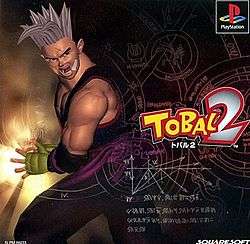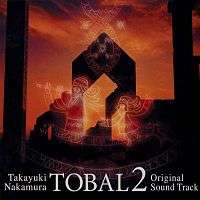Tobal 2
| Tobal 2 | |
|---|---|
 | |
| Developer(s) | DreamFactory |
| Publisher(s) | Square |
| Designer(s) | Seiichi Ishii (director and designer) |
| Composer(s) | Takayuki Nakamura |
| Platform(s) | PlayStation |
| Release date(s) |
(re-release) |
| Genre(s) | Fighting |
| Mode(s) | Single-player, multiplayer |
Tobal 2 (トバル2 Tobaru 2) is a 3D fighting video game developed by Dream Factory and released by Square in Japan in 1997. It is the sequel to Tobal No. 1. Unlike the latter, Tobal 2 was not released in North America or PAL territories. The game was re-released in 2007 under Square Enix's "Legendary Hits" label.[1]
The game currently holds the records for the largest character roster in a fighting game with a grand total of 200 playable characters to choose from, as well as a greatly expanded Quest Mode compared to its predecessor.[2]
Gameplay
The fighting system in Tobal 2 is the same as in the previous game. The player can freely navigate 3D fighting arenas under the condition that he or she faces the opponent. High, medium, and low attacks can be executed using assigned buttons. As in Tobal No. 1, the grappling and blocking system offers the player a variety of offensive and defensive maneuvers. A new unblockable fireball attack has been added for each character.[3] Tobal 2 was released on the same day as Sony's Dual Analog Controller in Japan, noted as the first game compatible with the peripheral.[4] Graphically, the game features Gouraud shaded and higher-resolution character models compared to Tobal No. 1, but still runs at 60 frames per second.[5]
The "Quest Mode" from Tobal No. 1 makes a return in Tobal 2. The game contains six dungeons (Practice Dungeon, Pyramid, Desert Spaceship, Molmoran Mine, Castle and Final Dungeon) to conquer. Unlike the dungeon-enclosed Quest Mode of the original, this incarnation also offers a fully explorable town that allows the player to eat, sleep, and shop. In each floor of the dungeons, the player will battle against a variety of monsters. When defeated, the monsters will drop either food, stones, potions, money or weapons. As the player progresses through the game, the character gains experience for each body part or type of attack (the most important being each arm, each leg, throwing and guard). The higher the level of the characters arms and legs and throw, the more damage an attack using that part will yield. Similarly, the higher the guard level, attacks on the character will yield less damage. Both attack and defence levels can be increased/decreased by potions and stones. Guard experience can also be accumulated by eating food when the stamina bar is (nearly) full.
By defeating monsters in the Quest Mode, the player has the option of capturing the monsters for use in the versus fighting mode, making the number of playable characters a maximum of 200. Some monsters are unique, such as the chocobo,[3] but many of them are just palette swaps with attributes raised for higher level monsters. Monsters can be captured by throwing a purple stone at them when they are nearly defeated. The progress of the Game can be saved using the church buildings in the town, and the character (consisting of additional data such as max hit points and attack/defence levels) can be used in the arcade and versus mode.
Characters
Playable characters
|
|
|
|
|
|
|
|
|
Development

Tobal 2 was to be released in North America but the release was cancelled. According to a Square official, the game was not localized due to the disappointing sales of Tobal No. 1, and the assumption that most of the people who did buy it only did so for the included playable demo of Final Fantasy VII.[6] Originally, it was thrown around that various third-party companies expressed interest in releasing the game but Square would not license the game to other companies. However, according to a feature in the February 2006 issue of Official U.S. PlayStation Magazine, Square representatives claimed that the game was never released because the PlayStation's limited memory prevented the English dialogue from fitting in the game's text boxes. A fan translation was completed little more than three years prior to the Square's official statement [7]
The Tobal 2 Original Sound Track was scored by Takayuki Nakamura, who also composed for the fighting games Virtua Fighter and Dream Factory's Ehrgeiz. Like the soundtrack for the game's predecessor, it includes a fusion of many different styles such as jazz, funk, and rock and roll.[8] When asked in an interview concerning the soundtrack who he was most influenced by, Nakamura stated "...the music styles of Chick Corea, Herbie Hancock and Jeff Beck."[9] The 20 track CD was released by DigiCube on April 21, 1997 in Japan.[10]
| Tobal 2 Original Sound Track tracklist |
|---|
Disc 1 (60:50)
|
Reception
| Reception | ||||||||||
|---|---|---|---|---|---|---|---|---|---|---|
| ||||||||||
Despite its exclusive release in Japan, the game has received relatively high praise among importers. GameSpot gave Tobal 2 an 8.1/10, finding that it is superior to Tobal No. 1 in every aspect and makes for "a great diversion from the norm." However, the website admits that it has no chance of competing with more popular fighting series such as Tekken and Mortal Kombat.[3]
Tobal 2 sold over 318,000 copies in Japan in 1997, making it the 31st best selling game of the year.[13] In 2000, Tobal 2 was ranked number 50 on Weekly Famitsu's 100 best PlayStation games of all time.[14]
References
- ↑ Spencer (November 15, 2006). "Square-Enix reprints their Legendary Hits". Siliconera. Retrieved 2008-11-10.
- ↑ Guinness World Records 2011 - Gamer's Edition. Guinness World Records Ltd. 2010. p. 122. ISBN 978-1-4053-6546-8.
- 1 2 3 4 Gerstmann, Jeff (May 8, 1997). "Tobal 2 Review". GameSpot. Retrieved 2007-09-08.
- ↑ IGN staff (April 3, 1997). "Analog Joypad To Go On Sale In Japan". IGN. Retrieved 2008-07-04.
- ↑ "Games You'll Never Play That You Should". GameSpot. Retrieved 2008-12-06.
- ↑ IGN staff (May 14, 1997). "Tobal 2 USA Launch Canned". IGN. Retrieved 2008-07-04.
- ↑ "Tobal 2 Translation Project". Retrieved 2007-12-11.
- ↑ Paredes, Alonso. "Tobal 2 Original Soundtrack". Soundtrack Central. Retrieved 2007-09-08.
- ↑ "RocketBaby's interview w/ Takayuki Nakamura". RocketBaby.com. July 4, 2000. Retrieved 2007-09-08.
- ↑ "Tobal 2 Original Sound Track". Chudah's Corner.com. Retrieved 2007-09-08.
- ↑ "1997's Famitsu Scores Archive". FinalFantasyTR.com. Retrieved 2008-11-02.
- ↑ Toose, Dan & Cheung, Kevin (April 1998). "Games of the Rising Sun: Tobal 2". Hyper. No. 54. Next Media Pty Ltd. pp. 34–5. ISSN 1320-7458.
- ↑ "1997 Top 30 Best Selling Japanese Console Games". The Magic Box. Retrieved 2008-06-06.
- ↑ IGN staff (November 20, 2000). "Famitsu Weekly PlayStation Top 100". IGN. Retrieved 2007-09-08.
External links
- Tobal 2 at Square-Enix.com